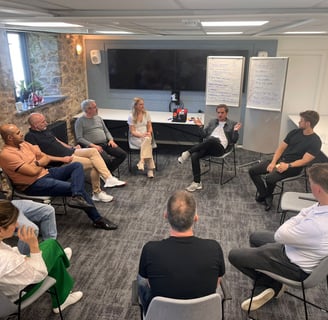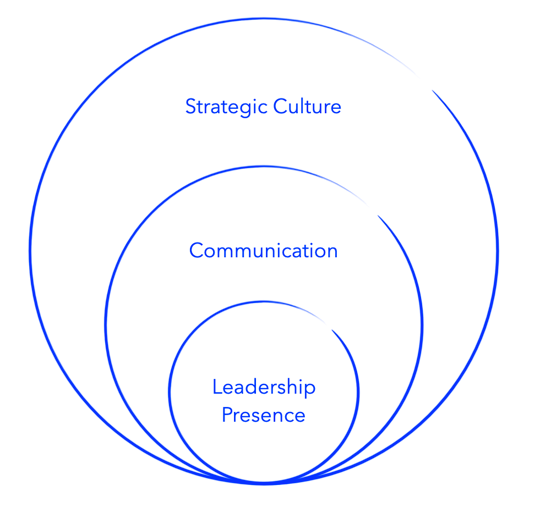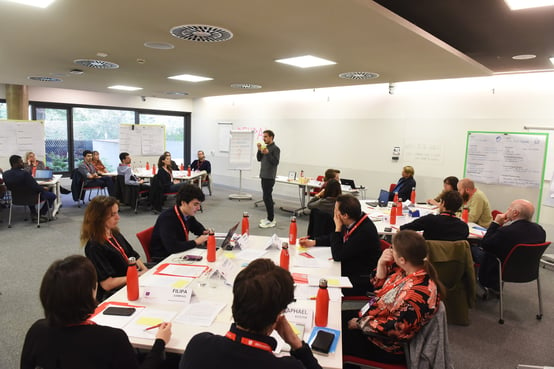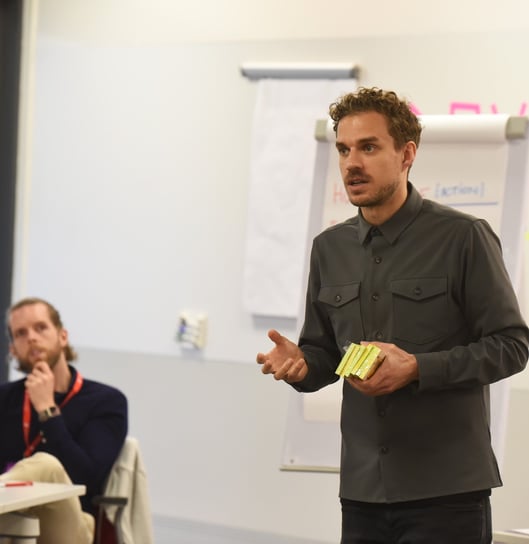When work clashes with human biology, burnout wins and teams lose.


Leadership in today's world
If you are anything like many of the ambitious leaders I met in my corporate career, a good number of the following things are true for you.
Your mind and heart feel committed to delivering results, but what has started out like an exciting mission now just feels like making it through the next day.
You have to spend a good amount of your time firefighting.
Your calendar feels more like playing Tetris on "ultra-hard" than being in control.
Many days, you leave the office late and drained of energy. This means it is much harder to be present with your family and friends in the way you promised yourself you would.
Your mind is continuously occupied, and even in breaks it is hard to find a moment of true rest.
Also, you have a team of smart, highly paid experts with their unique superpowers – but somehow business-as-usual seems to stop them from contributing at their best.
You and the team keep pushing harder, but the improvements in results are incremental at best.
In other words, you and your team are already operating at maximum capacity - but achieving your goals would need a significant leap. One that you are not sure how to do.
You worry that all this is not sustainable, neither for you nor your team.
What is more, it is hard to get real buy-in from important stakeholders across the organization, so things move slowly or not at all.
Important decisions are either met with silence or long, repeated discussions.
What truly matters is discussed too little, and people are getting lost in details.
Conflicts linger silently or explode in drama.
You think something needs to change NOW. And you suspect communication is an important part of the problem (but also of the solution).
(Full Disclaimer #1: I used to be the leader above.)


Imagine this ...
You are driving a car along the roads of the Californian coast. You have your friends with you. And everyone is so excited about the journey ahead.
After a few hours, warning signals start flashing in the cockpit of the car. You figure it's probably just the electronics acting up. These new cars can be kind of weird sometimes...
Some more time passes, and all of a sudden, everyone notices a biting smell of burned plastic in the car. You check the mirror and spot gray smoke coming off one of the rear wheels..
Now you pull over immediately. You get out of the car and inspect the outside. The smoke lightens, but the brake had clearly overheated. You can't continue until roadside assistance comes to replace the broken parts.
You later figure out when taking over the rental car, you released the handbrake all the way, just not the last two millimeters. So you kept driving with everyone onboard, making good progress on your journey.
What you didn't notice is that for the whole time, the brake created friction over time in the back, so at one point naturally the system overheated and stopped the journey in its tracks.
That's exactly what I see many teams do.
They do make progress on their journey, but they waste massive amounts of fuel (think: energy, money, talent) because they don't yet see the hidden friction in the mechanics of the car.
They keep driving, ignoring early warning sings ("let's just all try a little harder, shall we"), until parts finally break down.
As a result, they get to their destination much later, only after large amounts of additional resources than planned have been spent (budgets, talent, energy). Or they don't arrive at all.
So how can you release the handbrake of your team?
(Full Disclaimer #2: This is a true story that actually happened to me in 2011. Thank God for full coverage car insurance.)
Business-as-usual is survival mode.


Here is the simple reason why you and your team are struggling:
Our view of how we should work together, on a day-to-day basis, has been largely shaped in the industrial era.
Back then, we had no clue about the human nervous system, or what it needs to thrive.
We didn't have a vast amount of scientific research on what humans need to collaborate.
So we just took what works well in factories and applied it to team work and communication. Okay, we did update parts of it since then. But we largely haven't included what science knows about human nervous systems today.
In short: Business-as-usual runs against what human nervous systems need to thrive.
And it does work sometimes – it just takes massive amounts of energy.
And silently hinders you and your team from performing at their best.
The good news? By upgrading the operating system of your team to reflect what science knows today, you can stop wasting time, energy, and money and instead make alignment and aliveness your next competitive advantage.
The 3 Leverage Points
From my experience, there are three powerful leverage points that are either ignored or not dealt with effectively in business-as-usual. However, they are essential for allowing leaders and their teams to be at their highest level of effectiveness, resilience, and joy.
Leverage Point 1: Leadership Presence
Before a team can perform at its best, each of its members needs to know how to bring their full cognitive and emotional intelligence to the table. That starts with knowing what's actually happening on the inside (interoception) and on the outside (exteroception). It requires the capacity to being in touch with and regulating your own nervous system, to stay grounded under pressure, and generating an internal sense of ownership instead of external compliance. If people start contributing from this place, everything changes.Leverage Point 2: Communication
This, in turn, enables powerful communication. It’s not just about what’s said, but how—and whether people feel safe to contribute honestly. Operating unconsciously, the autonomous nervous system plays a massive role in that. Mostly without us noticing, it influences how communication is happening, how it sent and received, and whether it "lands". Think about your 1:1 meetings, your team meetings, the conversation in the coffee kitchen, or the presentation you are giving to dozens of people in your department.
Leverage Point 3: Strategic Culture
Culture is often seen as "touchy feely"—but in reality, it’s the set of shared assumptions about how we work together. These implicit rules shape behavior, performance, and morale. Every team has a culture, whether by design or by default. But when culture is made visible and aligned with the business mission, it becomes a strategic lever. When built on presence and powered by effective communication, culture amplifies outcomes: stronger results, deeper resilience, and a team operating in its "zone of genius".
From what I've observed, these layers build and reinforce each other in a way where higher levels build on the lower ones. Allowing your team to break through to their next level of performance, resilience and joy then hinges on finding the "weakest link" in the system and focus on developing that next.


But wait ... aren't you just one of these "New Work" people? We've tried that.
Glad you are asking.
Yes and no.
Yes – because it is fair to say that we've come a long way since Taylorism 😉, and New Work has brought a lot of very valuable tools and practices into organizations (Agile, Design Thinking, Service Design, Holacracy, Liberating Structures, etc.). Sometimes they miss the mark, but in my experience that comes down to whether they are used (1) in the right moment and (2) in the right way. I am certified in a few of them, use them regularly as part of my offering, and I think they have an important role in business.
No – because they all lack a clear appreciation of the human nervous system and/or how to connect this knowledge to actual leadership challenges and real business outcomes.


Can I just continue doing things the old way? We've come pretty far...
Honestly? Yes, you absoutely can.
In fact, my best guess is you and your team are delivering good or very good results already. And your drive for excellence and impact will likely continue to allow you and your team to move things forward.
My prediction, however, is that this will likely come at significant cost:
Continuous, high energy expenditure by you and your team that does not feel sustainable over the long term
Results will likely stay behind the real potential of the group of smart experts you have hired ... you are not reaching your "zone of genius" together
Retention might be average or even lower, with a real concern about key talent and knowledge leaving the team or organization
Burnout for one of your team members or even yourself might feel like a real possibility
Any of these might be a reality for you or not. And if they are not, even better. All I am saying is that as long as we continue to work against the biological reality of our nervous systems, we create large amounts of unnecessary friction that we need to compensate for by pushing harder ourselves, asking everyone else to work harder, and/or throwing large amounts of additional money at the problem.
Create work that delivers kick-ass results and feeds your soul.
So what can I do, Florian?
Whether you work with me or not, I recommend you find someone who has proven experience in assessing and developing the three leverage points outlined above:
Leadership Presence
Communication
Strategic Culture
Based on that diagnosis, you can together identify the most impactful lever in your specific context. And focus your investment where it results in the highest return.
Depending on the situation, the “right” solution(s) might involve:
External facilitation of high stakes meetings and gatherings (e.g. complex project kick-offs, leadership offsites, etc.)
1:1 leadership coaching
A targeted training intervention for your team
If you are interested to learn more, reach out below. I'd be happy to have a 30 min get-to-know call to see if we are a fit. And if not, I can likely recommend you someone who is.



